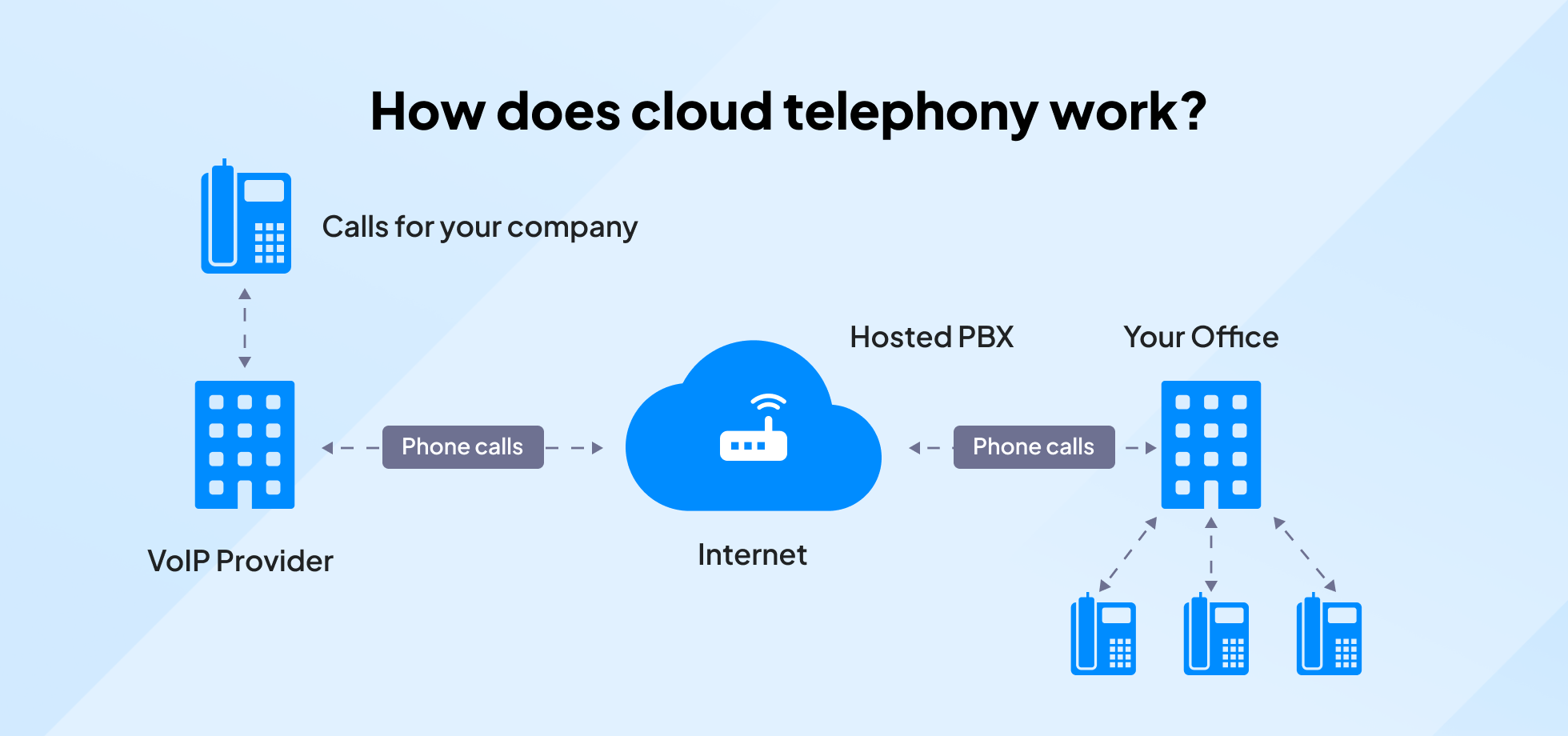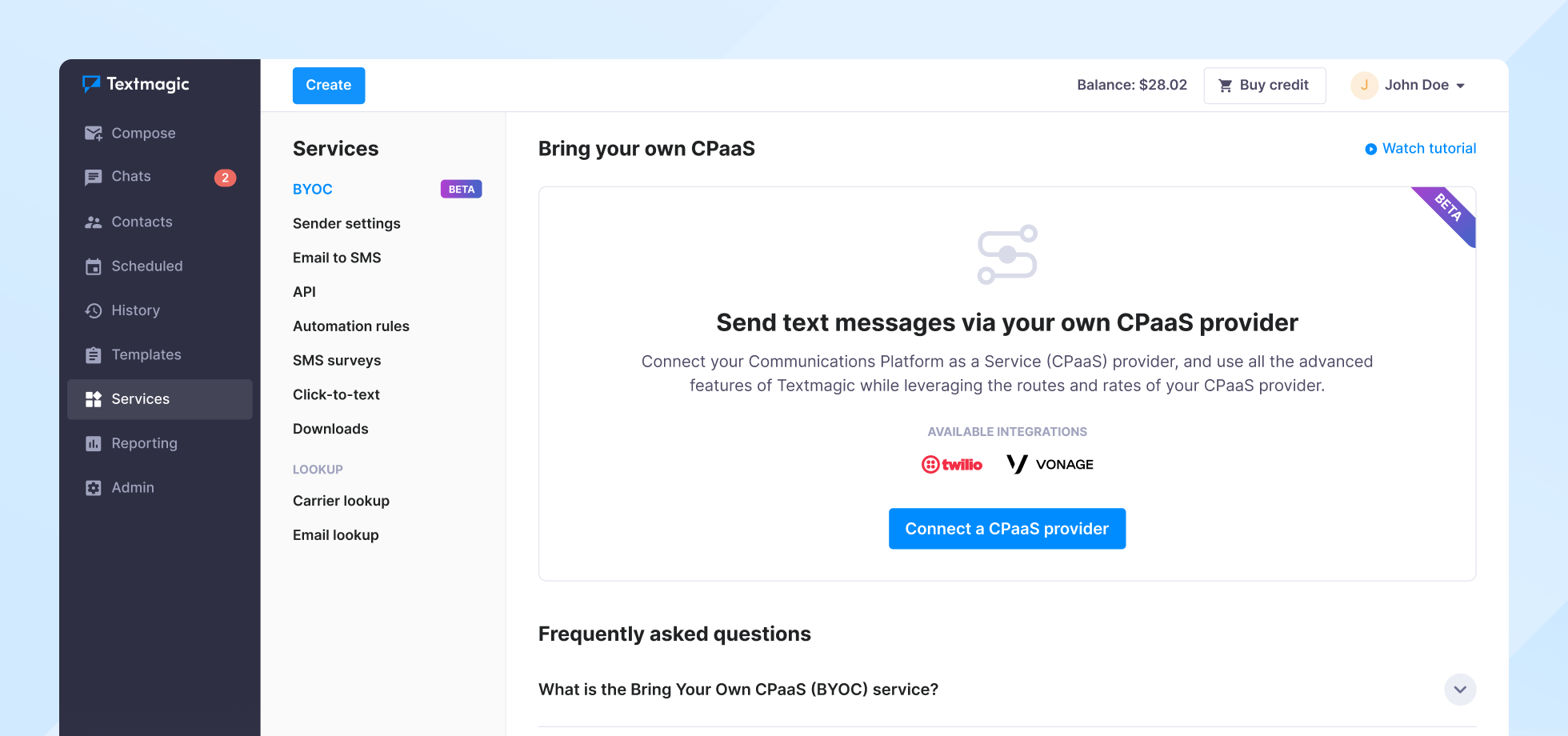
The evolution of business communication has been marked by constant innovation – from traditional mail and telegraph all the way to today’s email and Voice over Internet Protocol (VoIP) technologies.
Cloud telephony is the latest advancement in the industry, leveraging the power of the Internet to offer businesses a flexible and cost-effective solution for their communication needs. As part of the modern communication stack, it has managed to address the growing market demand for mobility and unification.
Together with applications such as cloud-based texting and multi-channel communication, cloud telephony kicked off a new era of limitless collaboration. In this article, we go over the inner workings of cloud telephony, from its definition to its benefits and more. Let’s begin.
What is cloud telephony?
Cloud telephony is a type of Unified Communications as a Service (UCaaS) that enables voice communication services through the cloud. It’s also known as cloud calling and uses the internet to make and receive calls instead of traditional private branch exchange (PBX) systems.
As a result, cloud telephony technology allows businesses to manage their phone systems through a dashboard. This makes adding new numbers, managing calls, and creating integrations with other tools easier, thus facilitating more agile and connected operations.
How does cloud telephony work?
Cloud telephony converts voice into digital signals and transmits them over the Internet using VoIP technology. This process replaces traditional hardware-based PBX systems with cloud-based PBX, which routes calls to and from phones and other devices connected to the service.

Thus, cloud telephony is more scalable and flexible than traditional telephony, which relies on lofty hardware to connect calls. This modern approach supports remote work, reduces costs, and enhances operational efficiency, reflecting the evolving needs of global business communications.
Cloud telephony vs. traditional PBX
On the one hand, cloud telephony utilizes PBX technology that is digitally hosted. There is no need for physical hardware on the business premises except for VoIP-enabled handsets if necessary. Everything is controlled from a web-based interface delivered by a third-party service provider.
Traditional PBX, on the other hand, does require various hardware components such as servers and trunk lines. It requires a dedicated team for upgrades and maintenance, all of which must be managed in-house.
In the table below, we’ve explored the differences between cloud telephony and traditional PBX regarding deployment, costs, and a few other relevant features.
| Feature | Cloud telephony | Traditional PBX |
|---|---|---|
| Deployment | Over the Internet (no physical hardware needed on-site) | On-site deployment (requires hardware and phone lines) |
| Scalability | High (users and features can be added or removed easily) | Low to moderate (additional hardware and higher costs) |
| Flexibility | High (remote work support and easy integration with other apps) | Low to moderate (changes require physical adjustments to the setup) |
| Maintenance | Third-party (handled by the service provider at no additional cost) | In-house (requires resources for upkeep and updates) |
| Initial costs | Low (primarily subscription-based with minimal upfront investment) | High (significant investment in hardware, installation, and setup) |
| Updates | Third-party (handled by the provider without disrupting operations) | In-house (requires manual implementation leading to downtime) |
Benefits of cloud telephony for businesses
Cloud telephony is a modern solution for businesses that need reliable and unified communications. It’s most beneficial for companies that are looking for:
- Fast setup: Streamlines phone deployment and lets businesses get their communication systems up and running quickly.
- Reduced operational costs: Lowers overall expenses by eliminating the need for extensive physical hardware and dedicated teams.
- Advanced call features: Offers an advanced suite of calling capabilities, such as auto-attendant, call forwarding, call recording, and interactive voice response (IVR).
- System flexibility: Easily adapts and scales according to business needs, allowing for the easy addition or removal of users and features as required.
- Enhanced mobility: Supports on-the-go communication, enabling employees to make and receive calls from anywhere and on any device.
- Unified communications: Simplifies collaboration by integrating voice, messaging, video calls, and file sharing in a single platform.
- Consistent uptime: Ensures reliable service with high uptime and disaster recovery capabilities through robust third-party infrastructure.
Cloud telephony is a great choice for large businesses that need to handle a high volume of communications across various departments and geographic locations. However, it might not always be the best option for SMBs seeking a no-fuss solution.
A communication platform like Textmagic can be more beneficial in this case. Here’s why:
- Textmagic’s services are generally more cost-effective, especially for SMBs or startups that need to keep overheads low.
- Textmagic is ideal for businesses prioritizing text messaging but still needing basic voice call management.
- The Textmagic platform is user-friendly, enabling quick setup and straightforward call forwarding management without technical expertise.
Disadvantages of cloud telephony
While the benefits of cloud telephony are indisputable, it’s important also to consider potential disadvantages to make an informed decision:
- Dependence on Internet connectivity: Relies heavily on a stable and high-speed internet connection, with poor quality leading to latency and call drops.
- Security and privacy concerns: Transiting private data over the web can expose businesses to cybersecurity flaws despite the robust measures providers usually take, making it essential for companies to leverage VPN benefits to add an extra layer of security.
- Higher cost over time: Usage beyond the plan and additional charges for extra features can be amassed over time.
- Reliance on third-party incident management: The resolution of incidents and service outages depends entirely on the cloud telephony provider, which can sometimes delay mitigation.
How to choose a cloud telephony provider
Choosing the right cloud telephony service provider for your business is important to ensure a smooth transition. These are the most important aspects to look at:
- Service reliability and uptime. Look for a provider that can guarantee high uptime rates. This will ensure business continuity and consistent service delivery.
- Cost and pricing structure. Evaluate pricing models and determine what fits your needs and budget alike. If you aim to reduce costs when transitioning from on-premise to hosted telephony, you can also use SIP trunking to connect your existing phone systems to the cloud.
- Feature set and integrations. Assess the range of capabilities a cloud telephony service has before choosing. Check that it seamlessly integrates with your existing CRM systems, email platforms, and collaboration tools.
- Customer support. Look for solutions that offer customer support with a proven track record of solving issues promptly. Make sure you understand the level of the specifics of the service level agreement (SLA) before committing fully to a service.
- Quality of service. The cloud-based telephony provider you select should be able to deliver clear voice quality and reliable service without lags or disruptions.
- Security and compliance. Compliance with local industry standards and regulations such as GDPR or HIPAA is a must. Proper security measures, data encryption, and data breach procedures are also decisive factors.
- User adoption levels. Consider the system’s ease of use and the training required for your team to use the new technology efficiently.
- Positive user reviews. Testimonials from other users can help you gauge how the service performs, how easy it is to set up, and what level of customer service it offers.
- Free demos and trials. While it’s not mandatory to go through a demo period before settling on a provider, doing so is a good way to determine whether or not it’s the right fit for your company.
How to implement cloud telephony
Implementing a cloud telephony system for your business is a multilayered process. When approached intelligently, it can greatly enhance your company’s communication strategy. Here’s a step-by-step guide:
1. Assess your business needs
Evaluate your current communication requirements. What types of calls are you planning to make? What features would benefit your business the most?
Your choice of provider and subsequent strategy can differ depending on whether you want to call locally or require international connectivity. The same goes for features, as multiple capabilities might require a more expensive implementation plan.
2. Choose the right cloud telephony provider
Make sure you choose a dependable cloud-hosted telephony provider that matches your business needs. Follow the criteria outlined in the previous section of this article for the best possible experience.
If you want to take your communications one step further, you can go for a Contact Center as a Service (CCaaS) provider, which brings advanced customer service features to the table.
3. Plan your strategy and configure your system
Decide on your number strategy. Will you port your existing numbers or get new ones? Will you be using toll-free numbers, 10DLC numbers, or something else?
Regardless of your answer, you need to work with your provider to configure the system settings, user accounts, and call routing rules to make this possible. Depending on your location, you might also need to reserve some time to verify your numbers.
4. Integrate with existing business applications
After planning and configuring your new service, it’s time to integrate it with any existing apps. A seamless connection between your cloud telephony system and business software, such as your CRM or email platform, will bring value to your operations.
Please note that this process may involve using APIs or middleware provided by the telephony provider or another third party. To ensure a smooth transition, you should have some developers on hand to delegate this responsibility to.
To streamline the process, you can go for a Communication Platform as a Service (CPaaS) provider, which empowers developers with ready-made SDKs for simple implementation. Some companies also offer Bring Your Own Carrier (BYOC) options that allow you to leverage any pre-existing carrier relationships you might have.

5. Train relevant team members
Before launching the service, you should train all team members who will use it. This should cover key areas such as making and receiving calls, utilizing advanced features, and integrating telephony tasks with daily workflows.
6. Perform tests before launching
Ideally, you should also perform system testing before going live with the cloud telephony solution. Check for call quality, feature performance, and compatibility with business workflows to ensure that everything works as expected.
7. Go live and collect feedback
Once you’ve ensured everything’s working as intended, you’re ready to go live with the solution.
Collecting feedback from your employees regarding the cloud telephony service’s performance post-launch is always a good idea. This way, you can optimize and upgrade as needed over time.
Conclusion
Transitioning to cloud-based telephony solutions offers businesses an unparalleled opportunity to stay competitive and responsive to market demands. The service’s flexibility, efficiency, and seamless integration capabilities make this possible.
Thus, embracing digital transformation through innovations such as cloud telephony has become necessary for businesses wanting to evolve. Adopting this technology into your operations is a pivotal step towards achieving success in the modern market.
Related articles
Textline vs. Textmagic: Feature comparison and key differences
Choosing the right business messaging platform can s...
How to use concept maps to organize complex ideas (plus free templates)
From marketing strategies to customer service workfl...
Conversational messaging: Transform customer engagement with SMS
Nowadays, businesses are adapting their communicatio...
SMS outreach: How to use text messages to engage your clients
Nowadays, staying connected with clients requires mo...
How to use SMS for property management: Benefits, use cases, and templates
Marketing your property can be a time-consuming and ...




